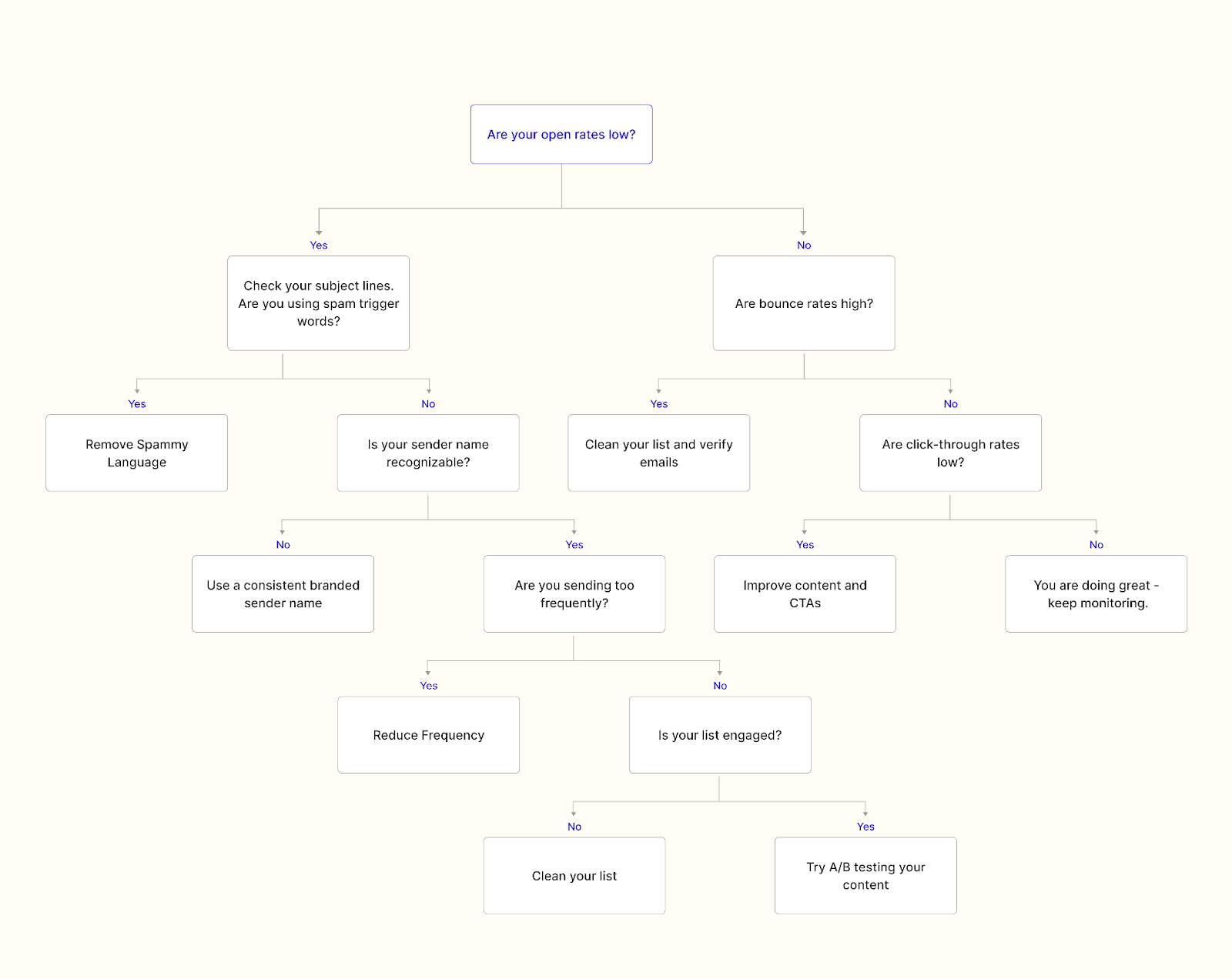Email Deliverability Audit: Pass Gmail/Yahoo Rules

If your emails aren’t reaching the primary inbox, every campaign is losing revenue before it even starts. You’ll see it as low open rates, falling clickthroughs, or messages landing in the Promotions tab, or worse, spam. These are email deliverability issues caused by weak authentication, poor list quality, or a damaged sender reputation.
Mailbox providers like Gmail and Yahoo now enforce stricter rules for bulk senders. They expect verified SPF, DKIM, and DMARC records, low spam complaint rates, and consistent email sending patterns. If your setup falls short, your email program suffers, even when your content and timing are perfect.
That’s where a Tie email deliverability audit helps. We review the full technical stack behind your email performance: domain authentication, sending domain/IP health, list hygiene, engagement trends, and content triggers. You get a clear diagnosis of what’s blocking inbox placement and a prioritized path to fix it.
This way, fewer emails end up in spam, you see better inbox placement, and get to drive higher returns from every send.
What is an email deliverability audit?
An email deliverability audit is a structured review of your domain setup, sender reputation, and campaign performance to understand why your emails may not be reaching the primary inbox. It helps you identify technical errors, list hygiene issues, or engagement gaps that hurt inbox placement.
But don’t confuse this with delivery. Delivery means that your email was accepted by the recipient’s server, while deliverability means it actually landed in the inbox, and not spam or promotions.
Read our email deliverability checklist for a detailed breakdown.

Signs you need an audit
If you’re unsure whether your domain needs an audit, look at your metrics. A drop in engagement or a spike in errors usually signals that your sender reputation is slipping. You likely need a deliverability audit if you notice any of these warning signs:
- Low Google postmaster domain reputation
- Spam complaints or hard bounces are rising steadily across campaigns.
- Falling open or click-through rates, even with consistent subject lines and offers.
- “Rate limited” or deferral warnings in Gmail Postmaster or ESP reports.
- Your domain or IP is appearing on blocklists like Spamhaus or Barracuda.
- Poor results in Klaviyo Health, where opens fall below 35% or clicks under 1%.
- Rising spam complaints, high bounces, falling opens/clicks, blocklist hits, Gmail “rate limited”/deferrals.
The email deliverability audit checklist: what’s included
Tie’s email marketing deliverability audit reviews every layer of your email infrastructure and engagement strategy, from authentication to list quality to content behavior. Each element is tested against real-world metrics that mailbox providers like Gmail, Yahoo, and Outlook use to decide whether your emails reach the primary inbox or get filtered into spam.
Below is what we audit, and how Tie’s deliverability experts handle each step. Some checks are built directly into our audit framework, while others are verified through our network of diagnostic tools and partner integrations.

Authentication & alignment
Tie verifies all essential email authentication protocols to make sure your sending domain passes mailbox security checks.
- Confirm that SPF (Sender Policy Framework), DKIM (DomainKeys Identified Mail), and DMARC (Domain-based Message Authentication, Reporting & Conformance) records are valid, aligned, and point to your correct “From” domain.

- Review DNS settings to confirm that records aren’t duplicated or misaligned across multiple ESPs.
- Validate any dedicated IP mappings to avoid shared infrastructure risks.
- Check for BIMI (Brand Indicators for Message Identification) setup. This is not mandatory but recommended for stronger domain trust and brand visibility.
If BIMI is missing, our experts flag it as a longer-term deliverability optimization step rather than a blocker.
Compliance with Gmail/Yahoo bulk-sender rules
Our experts validate all compliance factors introduced by Gmail and Yahoo in their 2024–2025 sender guidelines.
We check:
- One-click unsubscribe header and visible body link in all promotional campaigns.
- Unsubscribe processing within 48 hours, as required by ISPs.
- Spam complaint rate below 0.3%, a critical compliance threshold.
- Authentication alignment (SPF/DKIM/DMARC) and valid HELO or PTR records to prevent phishing misflags.
If your campaigns don’t currently comply, we include a corrective roadmap to bring them in line with the Gmail and Yahoo frameworks.
Reputation & inbox placement diagnostics
We pull your sender reputation and inbox placement metrics from multiple sources to measure how ISPs view your emails:
- Gmail Postmaster Tools: Spam rate, IP reputation, and domain reputation trends.
- Seed testing: Inbox placement results across Gmail, Yahoo, Outlook, and Apple Mail.
- Third-party deliverability tests: MXToolBox, Mail-Tester, Lemwarm, and Warmy.
- Blacklist monitoring: Real-time check for listings on Spamhaus, Barracuda, and UCEProtect.
Once we have the deliverability scores, Tie traces each signal to its cause, showing exactly which behaviors or setup issues are lowering your inbox placement. For instance:
- A spike in spam complaints may link to aggressive subject lines or repetitive offers.
- Low IP reputation could stem from a cold sending domain or an inconsistent warm-up.
- Falling open rates or click-through rates often trace back to stale email lists or disengaged segments.

Sending patterns & warm-up
Our experts then evaluate your sending domain and IP warm-up progress to guarantee your sending behavior signals trust to mailbox providers.
Our audit covers:
- Ramp rates: How quickly volume scales during new campaign launches.
- Consistency: Irregular spikes or “email blasts” that damage domain reputation.
- Segmentation throttles: Whether you’re pacing emails correctly for cold vs. active audiences.
Clients get access to Tie’s AI-powered warm-up engine, which automates deliverability recovery and domain reputation building. It simulates authentic engagement (opens, clicks, replies) to steadily increase inbox placement. This is complimentary for all deliverability clients.
List quality & acquisition (Tie advantage)
We identify every factor that impacts list hygiene and complaint rates:
- Invalid, inactive, or duplicate contacts that inflate bounce rates.
- Potential spam traps and low-consent signups.
- Imbalanced source mix; for example, purchased lists or forms without double opt-in.
Instead of relying solely on forms or popups, Tie’s Grow Email Lists feature captures high-intent web visitors (without requiring form fills), uncovering verified identity attributes. This allows you to:
- Send emails only to validated, high-quality contacts.
- Reduce spam complaints and hard bounces.
- Improve inbox placement rate and long-term domain reputation.
Content, template & UX
We analyze your email content, layout, and technical setup to identify friction points that trigger spam filters or reduce engagement.
Our checks include:
- Text-to-image ratio and total HTML weight.
- Valid and branded tracking domains (not ESP-branded).
- Reply-to domain consistency and active monitoring (avoid “no-reply” senders).
- Footer compliance with CAN-SPAM (address, company name, unsubscribe).
- Visible unsubscribe link in all emails.
- Clean, mailbox-friendly HTML without broken tags or hidden links.
- A/B testing recommendations for subject lines and copy tone that reduce “spammy” perception and improve open rates.
We also assess transactional emails for proper tagging to prevent deliverability overlap with marketing campaigns.
ESP configuration
Tie reviews your email service provider (ESP) configuration to make sure your setup supports reliable inbox placement and accurate performance tracking.
We validate:
- Dedicated sending domain and link tracking domain setup.
- Smart sending logic and suppression policies.
- Proper use of UTMs for attribution and reporting accuracy.
- Segmentation and sunset flow configurations.
- Transactional vs. marketing message separation to protect domain reputation.
Klaviyo specifics
Since many ecommerce brands use Klaviyo, Tie’s audit dives deeper into Klaviyo’s environment and benchmarks.
We review:
- Dedicated and your sending domain setup, link tracking domain, and authentication status.
- Flow hierarchy and coverage across welcome, browse/cart/checkout abandonment, post-purchase, and reactivation.
- Suppression settings, segment exclusions, and smart sending rules.
- UTM tracking for attribution integrity.
- Flow prioritization and delivery timing consistency.
- Benchmark comparison using Klaviyo’s email marketing metrics (e.g., 35% open rate and 1% CTR).
Measurement plan
Every audit includes a measurement and monitoring plan for 30–90 days post-fix to guarantee sustained improvement.
We define:
- Target thresholds:
- Spam complaints ≤ 0.3%
- Hard bounces ≤ 1%
- Soft bounces ≤ 2%
- Inbox placement rate ≥ 90%
- Monitoring cadence: weekly tracking through Postmaster Tools and deliverability dashboards.
- Rollback rules: temporary volume pauses if complaint rates exceed thresholds.
- Seed testing schedule to confirm inbox placement across ISPs.
Test email deliverability (fast checks you can run today)
Before running a full audit, you can run a few quick tests to gauge how mailbox providers view your domain. These checks won’t replace an in-depth review, but they give you early warning signals about potential issues with inbox placement or sender reputation.
Treat them as indicators (not guarantees) and always verify your findings with Google Postmaster Tools and real engagement metrics from your campaigns. Here are a few tests you can run today:
- MXToolbox Deliverability Test: Checks DNS records, authentication (SPF, DKIM, DMARC), and whether your domain or IP is on any known blocklists.
- Mail-Tester: Sends a test email and scores your message based on spam filters, header setup, and content risk factors.
- GlockApps Deliverability Tests: Simulate inbox placement across Gmail, Yahoo, Outlook, and other mailbox providers to identify whether your emails reach the inbox or land in spam.
Run these tests on your sending domain before your next campaign. If you see low inboxing scores, spam folder hits, or blacklisting alerts, don’t ignore them. They are early signs that your domain reputation is weakening.
Combine these results with Postmaster data (for Gmail-specific insights) and real engagement metrics (clicks, replies, conversions) to get an accurate picture of deliverability health.
If the tests show inconsistent inbox placement, rising spam folder rates, or blacklisting flags, it’s time to look deeper. Tie’s deliverability experts connect these test signals with identity data: identifying which audience segments, domains, or flows are lowering your sender trust, so you can fix the real cause, not just the symptoms.
What you get from a Tie deliverability audit
Tie’s email deliverability audit gives you a complete, data-backed view of how mailbox providers see your sending domain. It goes beyond basic diagnostics. You’ll know exactly what’s hurting your sender reputation, which authentication records are misconfigured, and how your email campaigns perform across ISPs like Gmail and Yahoo.
You’ll receive:
- A comprehensive checklist report covering authentication, compliance, list quality, sender reputation, content signals, and ESP configuration.
- A prioritized fix list, separating urgent technical errors from strategic improvements.
- A ramp plan that outlines how to safely rebuild sender reputation and scale volume without triggering Gmail or Yahoo filters.
- A testing roadmap: inbox placement, blacklist monitoring, and flow-level seed testing.
- Built-in guardrails for Gmail and Yahoo compliance, guaranteeing alignment with their 2025 bulk-sender policies.
Timeline & process
Once you share read-only access to your ESP, we begin testing the same day. Here’s how the process works:
- Day 1: Run baseline tests, like authentication, DNS, blacklist status, and inbox placement.
- Days 2–5: Analyze sender reputation, domain reputation, and audience engagement. Deliver a prioritized fix list with technical and strategic recommendations.
- After delivery: You can implement fixes internally or with Tie’s support team.
Our audits are fast but not rushed. We validate every issue before sharing results.
Most competitors deliver reports within 3–5 business days. Our team focuses on precision over speed.
How Tie helps improve deliverability
Fixing deliverability is more than adjusting SPF or DKIM. You need to send to the right people, from the right infrastructure, with the right signals. Tie’s system is built exactly for that.
- Promo Tab Protection offering: Tie gives brands a cutting-edge deliverability suite with a widget that ensures emails reach the Primary tab.
- AI-powered warm-up: Tie automatically warms your sending domain and IP address using real engagement signals, not artificial volume spikes—complimentary with every contract.
- Identity-first filtering: We use real visitor identity and enrichment data to remove fake or low-intent contacts from your email list before you send. This protects your IP reputation and reduces spam complaints.
Implementation (quick wins vs. longer plays)
A good audit is only useful if you can act on it. Tie’s report breaks recommendations into quick fixes, medium-term improvements, and long-term deliverability plays:
Quick wins:
- Fix broken SPF, DKIM, and DMARC alignment.
- Add one-click unsubscribe headers and repair missing reply-to addresses.
- Suppress inactive or cold emails that reduce your sender score.
- Validate DNS records and repair flows causing high bounce rates.
Medium-term:
- Execute your domain warm-up plan to rebuild trust with mailbox providers.
- Rework segmentation logic to focus on active, recent email engagement.
- Adjust email content and subject lines to avoid spammy triggers.
- Start seed testing and monitoring inbox placement weekly.
Long-term:
- Move toward full DMARC enforcement and BIMI verification for brand trust.
- Audit all list sources and reintroduce double opt-in where possible.
- Adopt identity-driven acquisition to improve list quality and future email deliverability rates.
Frequently asked audit questions
What is an email deliverability audit?
An email deliverability audit is a diagnostic review of why your emails do or don’t reach the primary inbox. Instead of looking at copy or design, it examines the technical and data foundations behind your sending, like domain authentication, sender reputation, engagement quality, and list health.
The goal of a deliverability audit is to identify what’s hurting inbox placement (SPF/DKIM/DMARC misconfigurations, stale contacts, spam traps, poor segmentation, etc.) and give a roadmap to fix it so more of your emails actually get seen — not filtered, throttled, or flagged as spam.
How long does an email deliverability audit take?
How long an email deliverability audit takes depends on your ESP, data volume, and domain complexity. Most competitors deliver audits in 3–5 business days, but Tie’s process often moves faster. Once we get read-only access, we start baseline tests the same day and deliver a full report within 2–5 business days, depending on depth and integrations.
What are Gmail/Yahoo’s key requirements I must meet?
Both Gmail and Yahoo now enforce stricter bulk-sender rules. To stay compliant and protect your deliverability:
- Set up and align SPF, DKIM, and DMARC.
- Include one-click unsubscribe in your email header and a visible unsubscribe link in every campaign.
- Keep spam complaint rates below 0.3% (watch in Gmail Postmaster).
- Use a consistent, aligned “From” domain.
- Process all unsubscribes within 2 days.
What’s a “good” spam complaint rate?
A healthy sender maintains ≤0.1% spam complaints across campaigns. Ideally, anything near 0.3% is a warning threshold since Gmail and Yahoo often treat it as a sign of poor engagement or weak list hygiene.
Monitor your spam complaint rate directly in Gmail Postmaster Tools and act quickly if it rises. Focus on suppression logic, segmentation, and engagement-driven sending instead of mass volume.
How do I test email deliverability for free?
You can run free diagnostic checks using these tools:
- MXToolbox Deliverability Test: Checks DNS, SPF, DKIM, DMARC, and blacklist status.
- Mail-Tester: Tests content quality, headers, and spam filter reactions.
- Lemwarm/Warmy Deliverability Test: Runs real inbox simulations.
What access do I need for a Klaviyo audit?
Tie typically requires Manager or Analyst access on your Klaviyo account with read-only permissions. This allows our team to review flows, authentication, suppression settings, and deliverability performance safely without altering your live setup.
Will warming hurt our brand if done wrong?
Yes, a bad warm-up strategy (sending too much, too fast) can tank your IP reputation and land campaigns in spam folders. Tie avoids this with an AI-powered warm-up system that automatically ramps send volume based on engagement and ISP response. It’s built into every deliverability project at no additional cost for clients.
Can adding lots of new emails hurt deliverability?
Yes, importing low-quality or unverified contacts increases bounce rates and spam complaints, damaging domain reputation. Tie’s identity resolution system fixes this by capturing high-intent, verified visitors directly from your website, enriching them with valid attributes before they ever enter your ESP.







